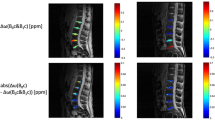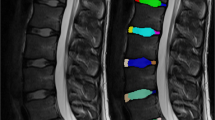Abstract
Objective
To investigate whether motion correction improves glycosaminoglycan chemical exchange saturation transfer imaging (gagCEST imaging) of intervertebral discs (IVDs).
Materials and methods
Magnetic resonance gagCEST imaging of 12 volunteers was obtained in lumbar IVDs at 3 T using a prototype pulse sequence. The data were motion-corrected using a prototype diffeomorphism-based motion compensation technique. For both the data with and that without motion correction (datac, datauc), CEST evaluation was performed using the magnetisation transfer ratio asymmetry (MTRasym) as a means of quantifying CEST effects. MTRasym and the signal-to-noise ratio (SNR) of the MTRasym map in the nucleus pulposus (NP) were compared for datac and datauc. A visual grading analysis was performed by a radiologist in order to subjectively quantify the quality of the MTRasym analysis (score 1: best quality, score 5: worst quality). Furthermore, a landmark analysis was performed in order to objectively quantify the motion between CEST images using the mean landmark distance dmean.
Results
MTRasym and SNR were significantly higher for the motion-corrected data than for the uncorrected CEST data (MTRasym(datac) = 3.77 % ± 0.95 %, MTRasym(datauc) = 3.41 % ± 1.54 %, p value = 0.001; SNR(datac) = 3.88 ± 2.04, SNR(datauc) = 2.77 ± 1.55, p value < 0.001, number of IVDs = 48). The visual grading analysis revealed a higher reliability for datac (maximum score = 2) compared with datauc (maximum score = 5). The landmark analysis demonstrated the superiority of the motion-corrected data (dmean(datac) =0.08 mm ±0.09 mm, dmean(datauc) = 0.36 mm ±0.09 mm, p value = 0.001).
Conclusion
Our study showed significant improvements in the ability to quantify CEST imaging in IVDs after the application of motion correction compared with uncorrected datasets.



Similar content being viewed by others
References
Haneder S, Apprich SR, Schmitt B, et al. Assessment of glycosaminoglycan content in intervertebral discs using chemical exchange saturation transfer at 3.0 Tesla: preliminary results in patients with low-back pain. Eur Radiol. 2013;23:861–8.
Balagué F, Mannion AF, Pellisé F, Cedraschi C. Non-specific low back pain. Lancet. 2012;379:482–91.
Deyo RA, Mirza SK, Martin BI. Back pain prevalence and visit rates: estimates from U.S. national surveys, 2002. Spine. 2006;31:2724–7.
Hart LG, Deyo RA, Cherkin DC. Physician office visits for low back pain. Frequency, clinical evaluation, and treatment patterns from a U.S. national survey. Spine. 1995;20:11–9.
Kim M, Chan Q, Anthony M-P, Cheung KMC, Samartzis D, Khong P-L. Assessment of glycosaminoglycan distribution in human lumbar intervertebral discs using chemical exchange saturation transfer at 3 T: feasibility and initial experience. NMR Biomed. 2011;24:1137–44.
Luoma K, Riihimäki H, Luukkonen R, Raininko R, Viikari-Juntura E, Lamminen A. Low back pain in relation to lumbar disc degeneration. Spine. 2000;25:487–92.
De Schepper EIT, Damen J, van Meurs JBJ, et al. The association between lumbar disc degeneration and low back pain: the influence of age, gender, and individual radiographic features. Spine. 2010;35:531–6.
Miese F, Buchbender C, Scherer A, et al. Molecular imaging of cartilage damage of finger joints in early rheumatoid arthritis with delayed gadolinium-enhanced magnetic resonance imaging. Arthritis Rheum. 2012;64:394–9.
Insko EK, Clayton DB, Elliott MA. In vivo sodium MR imaging of the intervertebral disk at 4 T. Acad Radiol. 2002;9:800–4.
Stelzeneder D, Welsch GH, Kovács BK, et al. Quantitative T2 evaluation at 3.0 T compared to morphological grading of the lumbar intervertebral disc: a standardized evaluation approach in patients with low back pain. Eur J Radiol. 2012;81:324–30.
Trattnig S, Stelzeneder D, Goed S, et al. Lumbar intervertebral disc abnormalities: comparison of quantitative T2 mapping with conventional MR at 3.0 T. Eur Radiol. 2010;20:2715–22.
Schmitt B, Zbýň Š, Stelzeneder D, et al. Cartilage quality assessment by using glycosaminoglycan chemical exchange saturation transfer and 23Na MR imaging at 7 T. Radiology. 2011;260:257–64.
Guivel-Scharen V, Sinnwell T, Wolff SD, Balaban RS. Detection of proton chemical exchange between metabolites and water in biological tissues. J Magn Reson. 1998;133:36–45.
Miese F, Kröpil P, Ostendorf B, et al. Motion correction improves image quality of dGEMRIC in finger joints. Eur J Radiol. 2011;80:e427–31.
Friston KJ, Williams S, Howard R, Frackowiak RS, Turner R. Movement-related effects in fMRI time-series. Magn Reson Med. 1996;35:346–55.
Eddy WF, Fitzgerald M, Noll DC. Improved image registration by using Fourier interpolation. Magn Reson Med. 1996;36:923–31.
Herrmann K-H, Wurdinger S, Fischer DR, et al. Application and assessment of a robust elastic motion correction algorithm to dynamic MRI. Eur Radiol. 2007;17:259–64.
Chefd’hotel C, Hermosillo G, Faugeras O. Flows of diffeomorphisms for multimodal image registration. IEEE Int Symp Biomed Imaging 2002 Proc 2002;753–6.
Chefd’Hotel C, Hermosillo G, Faugeras O. A Variational Approach to Multi-Modal Image Matching. Proc. IEEE Workshop Var. Level Set Methods VLSM01. Washington, DC, USA: IEEE Computer Society; 2001. Accessed 12 September 2013. Available at http://dl.acm.org/citation.cfm?id=832286.835648.
Kellman P, Viallon M, Chefd’hotel C, Stemmer A, Croisille P. Improved image reconstruction incorporating non-rigid motion correction for cardiac MRI using BLADE acquisition. J Cardiovasc Magn Reson. 2009;11:P227.
Kim M, Gillen J, Landman BA, Zhou J, van Zijl PCM. Water saturation shift referencing (WASSR) for chemical exchange saturation transfer (CEST) experiments. Magn Reson Med. 2009;61:1441–50.
Pfirrmann CW, Metzdorf A, Zanetti M, Hodler J, Boos N. Magnetic resonance classification of lumbar intervertebral disc degeneration. Spine. 2001;26:1873–8.
Hermosillo G, Chefd’hotel C, Faugeras O. Variational methods for multimodal image matching. Int J Comput Vis. 2002;50:329–43.
Liu Q, Jin N, Fan Z, et al. Reliable chemical exchange saturation transfer imaging of human lumbar intervertebral discs using reduced-field-of-view turbo spin echo at 3.0 T. NMR Biomed. 2013;26:1672–9.
Melkus G, Grabau M, Karampinos DC, Majumdar S. Ex vivo porcine model to measure pH dependence of chemical exchange saturation transfer effect of glycosaminoglycan in the intervertebral disc. Magn Reson Med. 2014;71:1743–9.
Müller-Lutz A, Khalil N, Schmitt B, et al. Pilot study of iopamidol-based quantitative pH imaging on a clinical 3T MR scanner. MAGMA 2014;10.1007/s10334-014-0433-8.
Longo DL, Busato A, Lanzardo S, Antico F, Aime S. Imaging the pH evolution of an acute kidney injury model by means of iopamidol, a MRI-CEST pH-responsive contrast agent. Magn Reson Med. 2013;70:859–64.
Wei W, Jia G, Flanigan D, Zhou J, Knopp MV. Chemical exchange saturation transfer MR imaging of articular cartilage glycosaminoglycans at 3 T: accuracy of B0 Field Inhomogeneity corrections with gradient echo method. Magn Reson Imaging. 2014;32:41–7.
Singh A, Haris M, Cai K, et al. Chemical exchange saturation transfer magnetic resonance imaging of human knee cartilage at 3 T and 7 T. Magn Reson Med. 2012;68:588–94.
Saar G, Zhang B, Ling W, Regatte RR, Navon G, Jerschow A. Assessment of glycosaminoglycan concentration changes in the intervertebral disc via chemical exchange saturation transfer. NMR Biomed. 2012;25:255–61.
Takashima H, Takebayashi T, Yoshimoto M, et al. Correlation between T2 relaxation time and intervertebral disk degeneration. Skeletal Radiol. 2012;41:163–7.
Acknowledgements
We gratefully acknowledge Erika Rädisch for her expert assistance with data acquisition.
Conflict of interest
No conflict of interest.
Author information
Authors and Affiliations
Corresponding author
Rights and permissions
About this article
Cite this article
Müller-Lutz, A., Schleich, C., Schmitt, B. et al. Improvement of gagCEST imaging in the human lumbar intervertebral disc by motion correction. Skeletal Radiol 44, 505–511 (2015). https://doi.org/10.1007/s00256-014-2034-z
Received:
Revised:
Accepted:
Published:
Issue Date:
DOI: https://doi.org/10.1007/s00256-014-2034-z




